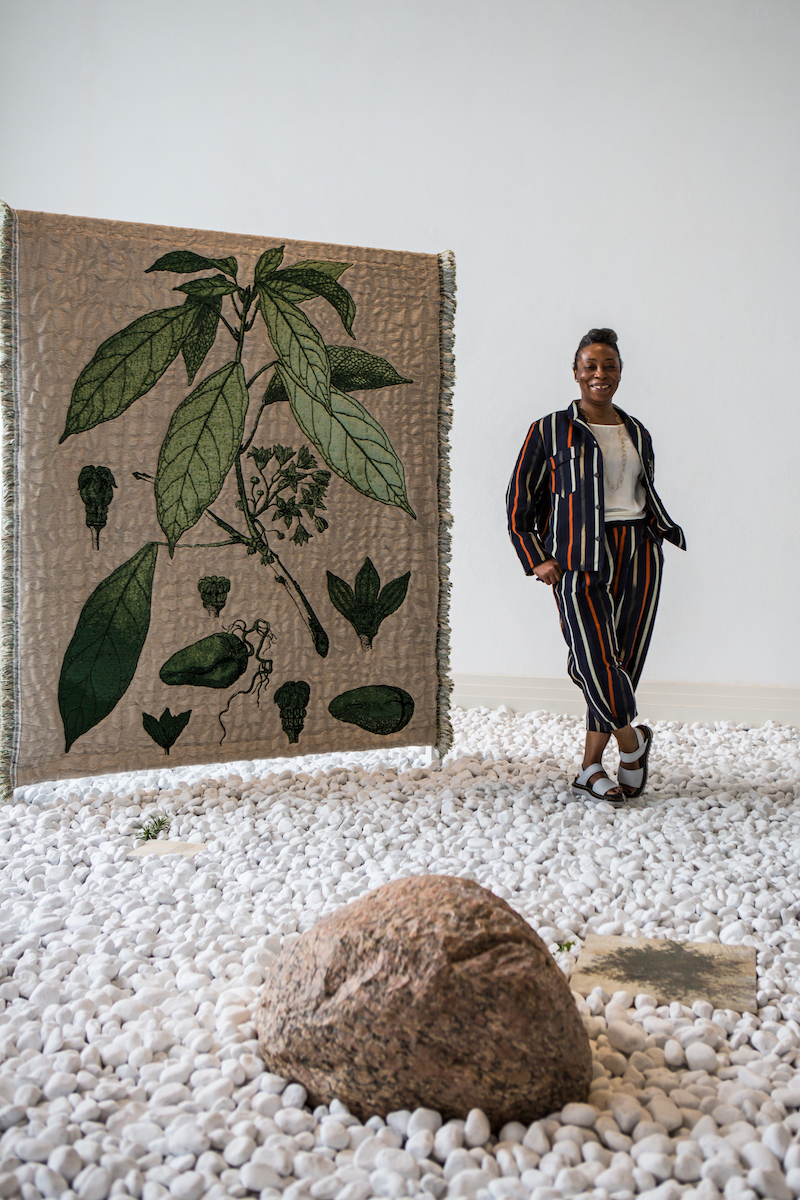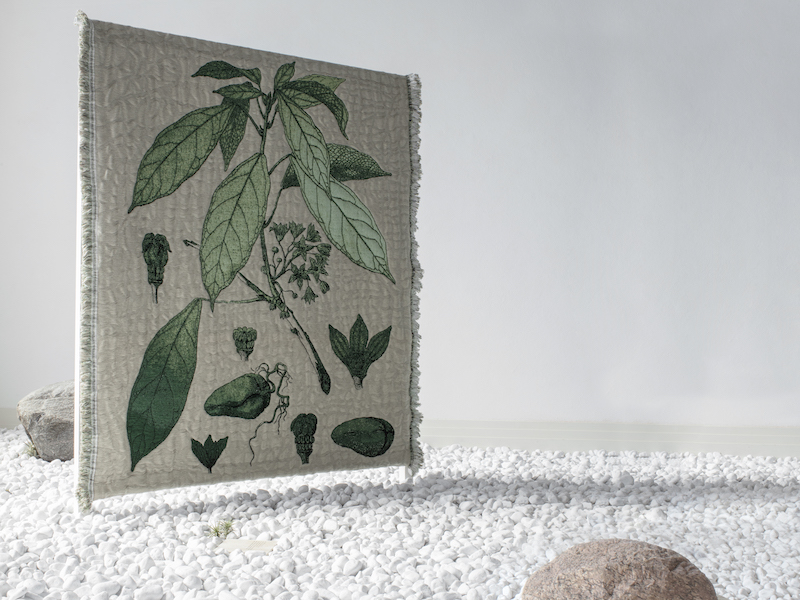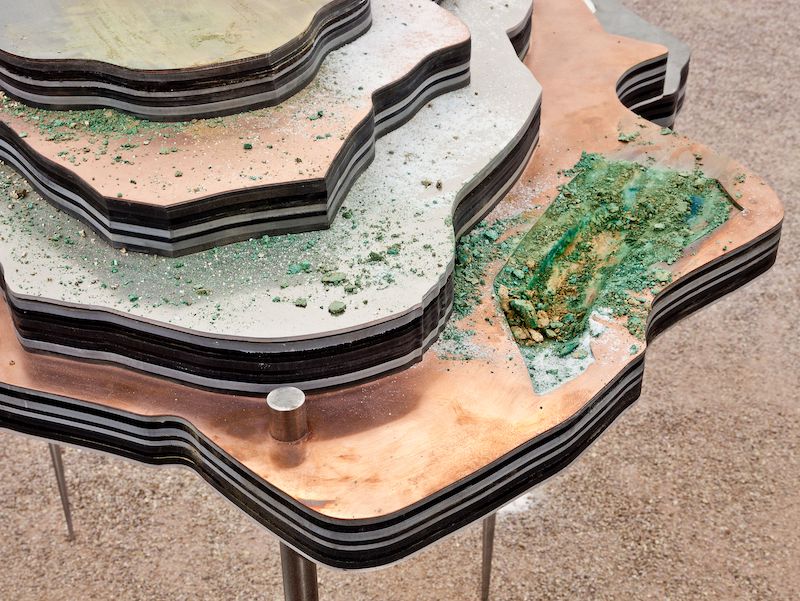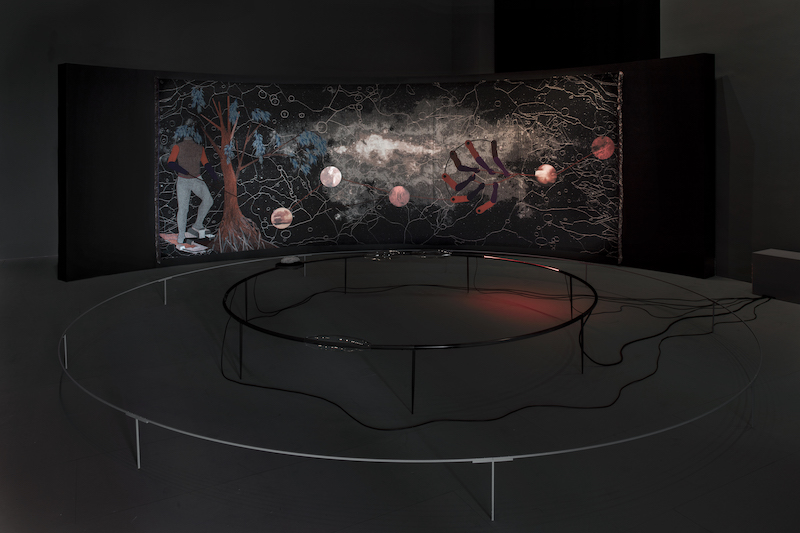Interview by Elizabeth Schippers // July 24, 2020
The multidisciplinary artist Otobong Nkanga, who was born in Kano, Nigeria and currently lives and works in Antwerp, focusses on the complex relationship between land and its inhabitants. Her exhibition ‘There is No Such Thing as Solid Ground’ at Gropius Bau addresses the exploitative systems of natural minerals and human labour, and works towards structures of repair. As such, the exhibition functions as a continuation of her 2019 residency at the museum and the structure of the exhibition itself works in terms of extraction and regeneration. The first piece one encounters, ‘Taste of a Stone’ (2010–2020), is a field of pebbles and is constructed as a place of contemplation, rest and regeneration. The rooms to the left and right of ‘Taste of a Stone’ can be seen as extractive, demanding the audience to exert energy as the body tenses and the mind focusses, only for you to be led into another room, to see another piece, where your breathing can calm again. The design is almost like a musical score – and that, Otobong explains, is precisely how she thinks of exhibitions. This way thinking also extends to her ideas of extraction and regeneration that are central to the work itself: “It is about creating a rhythm that can help amplify, accentuate, expand on the multiple parts. From the stomach, the chest, the head, the heart, all the different brains we have, for that to be entangled and work together.” Just before the exhibition opened to the public, we spoke with the artist about activity and dormancy, extraction and regeneration, breathing in and breathing out.

Otobong Nkanga: ‘Taste of a Stone’, 2020, site-specific installation, boulders, gneiss, granite, Icelandic lichen, inkjet prints on limestone, marble pebbles, movements, plants // Photo By Laura Fiorio
Elizabeth Schippers: Could you tell me some more about the title of the exhibition and how it relates to the pieces that are present in the exhibition at Gropius Bau?
Otobong Nkanga: I’m very much interested in how titles of works or of an exhibition set a certain tone. Since there were works that were continuously performative or shifting states, from the piece ‘Contained Measures of Shifting States’ [2012] to the voice work ‘Wetin You Go Do? Oya Na’ [2020], I needed a title that could bring all these works together. ‘There is No Such Thing as Solid Ground’ made a lot of sense in relation to how things are transiting, transforming, decaying and growing. It points towards the idea that a specific thing happening at a specific time is not what it is; it is not in its finality. A lot of things that we think are solid are actually in constant fluctuation. There is no place of stasis, there is nothing that is really solid. Because everything can melt away, everything can fall apart.
ES: One of the most impressive pieces to me in the exhibition was ‘Wetin You Go Do? Oya Na’. Could you expand on the development of that work and your thoughts behind it?
ON: The work ‘Wetin You Go Do? Oya Na’, originally ‘Wetin You Go Do?’, was first made for the Lyon Biennale in 2015. In that version, the sound was in heavy, concrete balls. The way of thinking about that work came from many things: social media, the ways in which people comment, having and hearing multiple voices, having multiple opinions and emotions. How do you create a work that can bring in all these kinds of parameters? That was my interest.
When recording the audio, I had eight mics. Some were around my throat, a few at different angles around my mouth and some were around my hands, so I could talk and at the same time snap my fingers or clap my hands. The piece started making sense and grew as I was working. The first day, I would listen to what I sang, and the next day I would sing over what I had created the first day to create a kind of polyphony of voices.
The idea of dragging out and pulling out all kinds of emotions was very central to the work. There many different characters when reading social media comments on one specific topic, and for me it was very important to translate that multitude of emotion in the work. Another aspect of it was to bring in that space of weightiness. As we feel the weight of others, hopefully we can find a place of empathy. Maybe it allows us to understand the other. This idea of constant commentary has opened up a place of wanting to understand, but also not wanting to understand, of guarding positions, of fighting against each other. And there is, in all of this, the feeling of almost a concrete ball, of a weight that stays in the stomach, in the chest, in the head. I think it is important to bring in that aspect of that weight.
Also, even if you do not understand the different kinds of English, because there are all kinds incorporated in this work, it doesn’t leave you indifferent. The language and tonation have been played with. You can really work with language to play with places of confidence, of brokenness, of numbness, of sadness. And by breaking a word, you can accentuate that.

Otobong Nkanga: ‘Taste of a Stone’, 2020 // Photo by Luca Giradini
ES: When I was in the room where ‘Wetin You Go Do? Oya Na’ takes place, even if I didn’t understand what was being said, the weight and the emotion came through. You also incorporated a few poems in this exhibition. Can you talk a little bit about the use of written language in your work?
ON: Generally, I don’t like writing. I feel so limited by the structures of how to write. The stumbling on a comma or a question mark creates for me a space of frustration. So, I write the same way I talk. I write as my brain works, and I have to find a way or form that allows me that freedom. I want to be able to play and to mess up. With poetry, I realised that I love playing with words and that I can allow myself that space to play with language. Like if I think of “bold”, I naturally think of “old”, of “hold”, of “fold” and “reload”. I can sit down and create words upon words with a kind of phonetic approach. From there, it can allow for “to hold” and “behold” and “oohhh lord”. And that—poetry—allows me to tie it to a place of emotion, because I work a lot with things that are not related to facts or statistics, but more in relation to feelings, emotion, intuition. Poetry allows for the use of both senses: for your brain to work and to simultaneously go into a place of emotion, intuition and sensation. I think that combination is what allows me to work with poetry, because then it doesn’t really matter if it is grammatically correct or not. If I want to stretch a word, I can stretch it. I can make it “hooooooooold on”. You can break the language, you can play with it. If you can read it in this way, you can read it in another way. It allows for duality and multiple angles of entry. There is no one way of thinking about something.
ES: How do you see your role as an artist within the institution, especially as it relates to the ability or necessity to critique extractivism and work towards repair?
ON: It’s a very complicated thing, because sometimes you do not know all the ins and outs of what an institution is or does. We think of an institution as a block, but I see museums and institutions as places where we can rethink ways of working. We can set certain conditions that allow for the people that we work with to be paid correctly, to be considered important. Without them, the show does not happen. So how do we make sure that the people we work with, like the performers, are paid well and are taken care of? As an artist, there are certain things you put in place to be able to discuss that, to make sure it happens, and you negotiate with the people of the institution. It should be a continuous work, a continuous strategy.
Wherever you go as an artist, you should implement certain conditions that you clearly say from the beginning: “This is what is demanded. This is what my work needs and what it entails in relation to the people I work with.” In relation to the kinds of people that are also exhibiting at the institution, it is important that you mention what you see or don’t see, so the people working in these institutions become aware of the fact that it is important to have diverse groups of people in their exhibition spaces. But that is a collective thing. It needs multiple voices and we need to not only be criticising but also trying to find practical ways in which institutions can work and can change ways of extraction. So, for artists, it is really important to create a strategy, to be in discussion with institutions.
But there are different kinds of conditions that makes it very difficult for an institution to change. There are moments where everything explodes and then everyone goes back to business as usual. So there has to be a constant shift for it not to solidify. It should be a system that is constantly checked. It has to adapt and shift as times change and as other people become part of its history. It needs to include and care for these different parts.

Otobong Nkanga: ‘Solid Maneuvres’, 2015, Crumbling Through Powdery Air, Portikus // Photo by Helena Schlichting
ES: You have mentioned that you are very interested not only in the ways of extraction but also in the ways that things come together, in fusions of elements or energies. Could you elaborate on that?
ON: One of the works that really goes with that kind of thinking is ‘Carved to Flow’ (2017–2020). I got the oils that I used for making ‘O8 Black Stone’ soap from Athens and the question became: how does one put something back in a place where things have been taken out? Because it is important for me that should be about generative practices, about remediation or liveability, breathability and expandability. It doesn’t mean that we cannot extract – we can still take out from a place, but do you leave holes in those places? How do you give time for those places to heal?
The amount of energy, funds and care that is put into regenerative practices is almost always too little. Countries give a lot of money to security, to war, to fight terrorism, into all those other things, but the care for the people that live there is minimised. And still, the people are blamed for the system not working, so it makes sense to consider how we can flip these ways of thinking. For me, the works in this exhibition and working together with all these people have allowed me to understand a lot more about this relationship between extraction and regeneration. When you have someone you have worked with, you grow together emotionally, spiritually, financially, on all levels, and you support each other. There can still be conflict, but you see the other person is in a better mental state and you are able to continue the journey together.

Otobong Nkanga: ‘Double Plot’, 2018, tapestry (woven textile and photography), yarns , acrylic and inkjet print on 5 laser cut metal plates, organic cotton, cash-wool, polyester, viscose // Photo by Luca Giardini
ES: And that restoration takes place on every level, from the personal to the systematic.
ON: Yes, on all levels – from the water you drink and the air you breathe to the mental and psychological effects on every single part of our bodies. Once you start realising that it is so interconnected, you start to realise the need to find systems that allows for a certain place to rest. When we go to sleep, we regenerate. The next day we go out to work, we expense energy, we have to regenerate again. But at the speed that we’re going, there is no space for regeneration, especially once that place has a resource or an element that can be extracted, and can be capitalised to bring in gains and money. Then it is depleted to a state that it cannot regenerate or takes much longer to regenerate. So for me, there is the extractive part, but it is mostly about how to allow things to sleep, to be dormant. ‘Carved to Flow’ also talks about dormancy; it is asleep, but it is still active. It’s not dead, it’s just resting. It’s waiting for the right moment to come out, to be exposed. You need a lot of dormancy.
Exhibition Info
Gropius Bau
Otobong Nkanga: ‘There is No Such Thing as Solid Ground’
Exhibition: July 10–Dec. 13, 2020
berlinerfestspiele.de
Niederkirchnerstraße 7, 10963 Berlin, click here for map



















